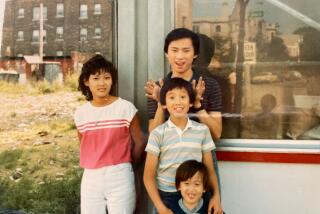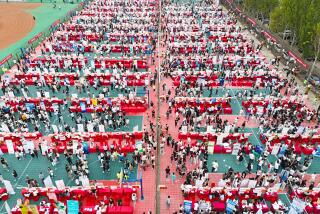Book Review : Leaden Learning Clouds China Study
- Share via
Children of China: Voices From Recent Years by Ann-ping Chin (Alfred A. Knopf: $22.95; 306 pages)
Just to describe the circumstances surrounding this book poses a major challenge. In some ways the circumstances might overshadow the text, or, I suppose, seen in another light they might even enhance it. This book is made up of four parts:
--In 1979, Ann-ping Chin accompanied psychologist June Esserman to China, to work on what was to be “a major psychological survey of Chinese children.” Then, Esserman died, but the 1979 set of raw interviews remained. At that point, Ann-ping Chin seems to have served mainly as an interpreter.
Heavily Academic
--On the other hand, Chin has received a Ph.D. in Chinese philosophy from Columbia. Thus, the 47-page introduction here, so heavily academic as to be almost unreadable, even by another Ph.D. Let me put it more plainly: The introduction is pure torture.
--Chin, married now, and with children of her own, returned to China in 1984. She conducts more interviews with more children. And another “voice” creeps in, not the voices of the children, but Chin herself, writing not like a philosopher, but a human being: “Nei-Jing is 16 but might be 12. Her hair is slightly curled, tied in two pigtails and her attire is girlish--a simple blue cotton dress zipped up the back . . . she likes to hasten through her sentences.”
--And, finally, a 20-page “Afterword,” written much less densely than the introduction but still dotted with (what might be an appropriate) learning. The Afterword begins, for instance, with a long quote from Walter Pater , certainly not someone we’d think of in connection with Chinese Communist children grumbling about their homework.
So, looking at “Children of China” purely in terms of structure, you can see that at least a quarter of it is written by Chin herself, in several different tones of voice--philosopher in the beginning, “introducer” of these kids all along the line, and schoolmarm at the end, summing up and interpreting what these children have been saying and doing.
Just to thicken the plot, some of these kids are very young (heavily into catching birds for instance and then letting them die by mistake), while some of them are as old as 19, saying things like “Without the Liberation, there still would have been development in science and technology--this I admit. But I think scientific development should be carried out for the sake of improving people’s livelihood. . . .”
In other words, everything that could be done to mess up this book, has been done. But for a person interested in China, it’s worth reading for the clues to daily existence that still shine through. The differences, for instance, in family life between living in an apartment house where nobody knows each other, and in an old-fashioned compound where everybody gets to know everybody else in the courtyard.
The sense that the extended family in China might be whittling itself down: although some of these children live with 12 or 13 relatives, some of the most touching accounts come from the ones who live alone with single parents. The heartening sense that children here and there must be in some ways more alike than different: the complaints about having to write an “eight-legged” essay there and a “five-paragraph” essay here sound exactly the same. And no one, anywhere on earth, likes to do the dishes.
Moved to Taiwan
Chin comes from a mainland Chinese family that moved to Taiwan in 1948. If I read that introduction correctly, the author’s philosophical position is: In China, the ancient traditions still rule. Confucius and Mencius far, far outweigh anything the Communists have done in the past 60 years. That’s a popular theory, I know, but a hard one to prove, no matter how many scholars you quote. (The new single-child policy, barely alluded to here, could destroy huge chunks of traditional, Confucian behavior.) Also, I don’t think these children of China “prove” much of anything set up in that bulldozer introduction. The thing to do here is throw out the theory and listen to the kids. They’re alive, touching, enthusiastic, wonderful.


